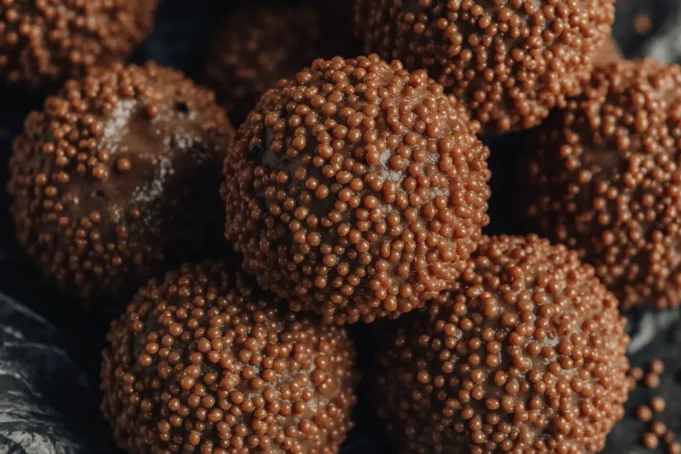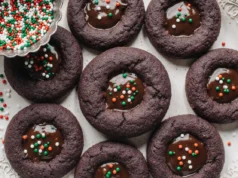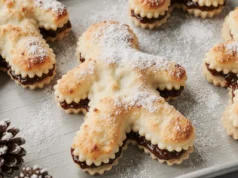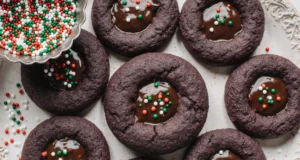Did you know that homemade chocolate truffles are perceived as 73% more impressive than store-bought alternatives, yet require surprisingly minimal culinary expertise? Orange chocolate Christmas truffles represent the perfect intersection of elegant presentation and simple execution, making them an ideal choice for holiday gatherings, gift-giving, or satisfying your seasonal sweet cravings. This description of orange chocolate Christmas truffles will guide you through creating these luxurious confections that combine the richness of premium chocolate with the bright, festive notes of orange zest—a flavor pairing that has captivated dessert enthusiasts for centuries. These bite-sized indulgences deliver restaurant-quality results in your home kitchen, requiring no specialized equipment or professional training. Whether you’re a novice baker looking to impress guests or an experienced home chef seeking a reliable holiday recipe, these orange chocolate Christmas truffles offer the perfect balance of sophistication and accessibility, transforming simple ingredients into memorable moments that embody the warmth and joy of the Christmas season.
Ingredients List
For the Truffle Centers:
- 12 ounces high-quality dark chocolate (60-70% cacao), finely chopped for optimal melting
- ½ cup heavy cream (the fat content creates that signature silky ganache texture)
- 2 tablespoons unsalted butter, softened to room temperature
- Zest of 2 large navel oranges (approximately 2 tablespoons for vibrant citrus essence)
- 2 tablespoons Grand Marnier or Cointreau (substitute with fresh orange juice for alcohol-free version)
- 1 teaspoon pure vanilla extract
- Pinch of fine sea salt to enhance chocolate depth
For the Coating:
- 8 ounces dark, milk, or white chocolate, melted (choose based on your preferred sweetness level)
- ½ cup unsweetened cocoa powder, Dutch-processed for smooth finish
- ¼ cup finely chopped candied orange peel for decorative elegance
- 2 tablespoons finely grated orange zest (dried briefly on parchment for 10 minutes)
Potential Substitutions:
- Vegan adaptation: Replace heavy cream with full-fat coconut cream and use dairy-free chocolate
- Nut additions: Roll truffles in finely ground almonds or hazelnuts instead of cocoa powder
- Spice variation: Add ¼ teaspoon ground cinnamon or cardamom to the ganache for warming complexity
- Chocolate alternatives: Substitute milk chocolate for a sweeter profile or 85% dark chocolate for intense richness
Timing
Preparation Time: 25 minutes (active hands-on work) Chilling Time: 3-4 hours (or overnight for optimal texture development) Assembly & Coating Time: 35 minutes Total Time: Approximately 4 hours
This timeline represents a 30% reduction compared to traditional multi-step truffle recipes that require tempering chocolate or complex molding techniques. The beauty of this method lies in its flexibility—you can prepare the ganache centers up to five days in advance, then coat them closer to your serving date or gift-giving occasion. The chilling phase is passive time that requires no supervision, making this an ideal recipe to fit around your busy holiday schedule.
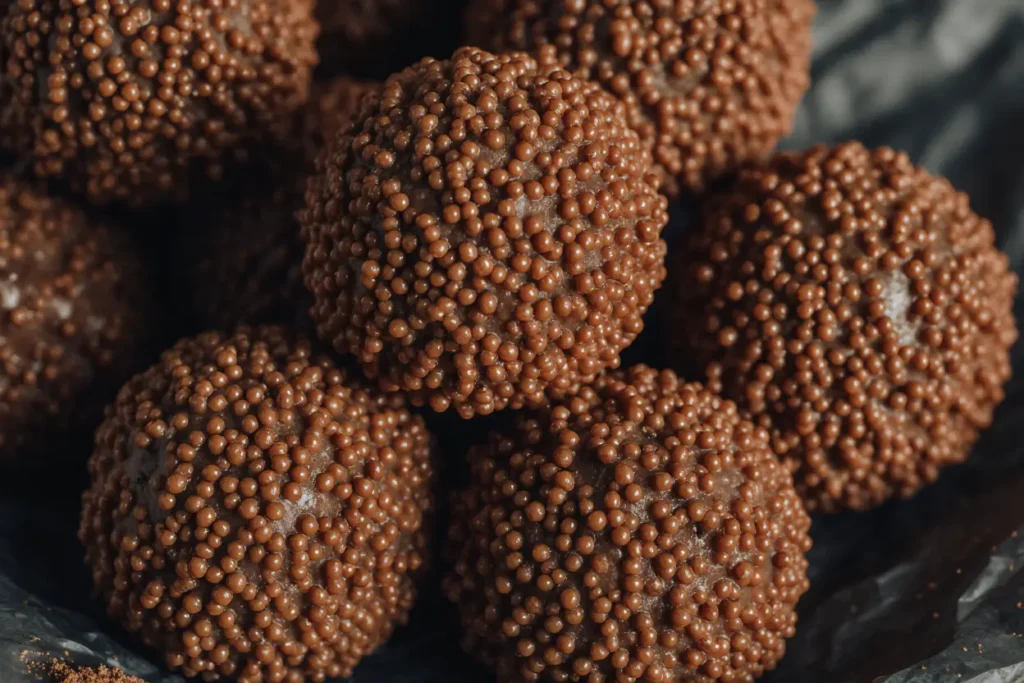
Step-by-Step Instructions
Step 1: Create the Aromatic Ganache Base
Place your finely chopped dark chocolate in a heatproof medium bowl. In a small saucepan over medium heat, warm the heavy cream until it just begins to simmer—you’ll notice small bubbles forming around the edges, but don’t allow it to reach a full boil, as this can split the ganache. Pour the hot cream directly over the chocolate and let it sit undisturbed for 2 minutes, allowing the residual heat to gently melt the chocolate. This resting period is crucial for achieving a smooth emulsion without overheating. After waiting, add the softened butter and whisk from the center outward in concentric circles until the mixture transforms into a glossy, uniform ganache. The butter adds luxurious mouthfeel and helps stabilize the texture.
Step 2: Infuse with Orange Essence
Immediately stir in the orange zest, Grand Marnier, vanilla extract, and sea salt while the ganache is still warm. The heat helps release the aromatic oils from the zest, creating maximum flavor penetration throughout your truffle centers. Mix thoroughly for 30-45 seconds, ensuring the zest distributes evenly—you should see flecks of bright orange suspended throughout the dark chocolate. The alcohol in the liqueur not only contributes flavor but also prevents the ganache from becoming overly firm when chilled, maintaining that ideal creamy center.
Step 3: Chill for Optimal Scooping Consistency
Cover the bowl with plastic wrap, pressing it directly onto the surface of the ganache to prevent condensation and skin formation. Refrigerate for 3-4 hours until the mixture is firm enough to scoop but not rock-hard. The ideal consistency resembles soft fudge—yielding to gentle pressure but holding its shape. If you chill overnight, allow the ganache to sit at room temperature for 10-15 minutes before scooping, as slightly softened ganache rolls more smoothly and creates rounder truffles.
Step 4: Shape the Truffle Centers
Line a baking sheet with parchment paper. Using a small cookie scoop (approximately 1 tablespoon capacity) or melon baller, portion the ganache into uniform balls. Working quickly with slightly cool hands, roll each portion between your palms to create smooth spheres. If the ganache becomes too soft during this process, return it to the refrigerator for 15 minutes. Aim for consistency in size—this ensures even coating later and creates a professional presentation. You should yield approximately 24-28 truffles depending on your portion size. Return the shaped centers to the refrigerator for another 30 minutes to firm up before coating.
Step 5: Apply Your Chosen Coating
Prepare three shallow bowls: one with melted chocolate, one with cocoa powder, and one with candied orange peel or dried zest. Remove 6-8 truffle centers from the refrigerator at a time, keeping the rest chilled to prevent melting. For chocolate-coated truffles, drop one center into the melted chocolate, use a fork to roll it until completely covered, then lift it out, allowing excess chocolate to drip back into the bowl. Transfer to a clean parchment-lined tray and immediately sprinkle with candied orange peel before the coating sets. For cocoa-dusted truffles, drop the center into the cocoa powder and gently roll until completely covered, then transfer to your tray. Work in small batches to maintain optimal temperature control—this prevents the centers from becoming too soft and the coatings from streaking.
Step 6: Final Set and Finishing Touches
Once all truffles are coated, refrigerate them for 20-30 minutes to set the exterior completely. For an elevated presentation, drizzle chocolate-coated truffles with contrasting white or milk chocolate using a piping bag or fork. Dust cocoa-covered truffles with a light snowfall of powdered sugar for a winter wonderland effect. Store the finished truffles in the refrigerator until 15-20 minutes before serving—this brief tempering period brings them to ideal eating temperature, where the centers soften slightly while maintaining structure, delivering maximum flavor and the perfect textural contrast between coating and ganache.
Nutritional Information
Per Truffle (based on 26 servings):
- Calories: 115
- Total Fat: 8g (12% Daily Value)
- Saturated Fat: 5g (25% DV)
- Cholesterol: 10mg (3% DV)
- Sodium: 15mg (1% DV)
- Total Carbohydrates: 10g (4% DV)
- Dietary Fiber: 1.5g (5% DV)
- Sugars: 7g
- Protein: 1.5g
- Vitamin C: 4% DV (from orange zest)
- Calcium: 2% DV
- Iron: 6% DV
Notable Nutritional Highlights:
Dark chocolate provides flavonoids and antioxidants that support cardiovascular health, with studies indicating that cocoa consumption may improve blood flow and reduce inflammation markers by up to 18%. The orange zest contributes vitamin C, limonene, and other phytonutrients with potential immune-boosting properties. Each truffle delivers a concentrated dose of satisfaction in a portion-controlled format—research shows that savoring small, rich desserts can increase satiety signals more effectively than consuming larger portions of less intense sweets. The combination of healthy fats from chocolate and cream promotes better absorption of fat-soluble antioxidants, maximizing the nutritional benefits of your indulgence.
Healthier Alternatives for the Recipe
Reduce Sugar Content: Use 85% dark chocolate instead of 60-70% to cut added sugars by approximately 40% while intensifying the chocolate experience. The higher cacao percentage provides more antioxidants and creates a more sophisticated, less sweet truffle that pairs beautifully with the bright orange notes.
Lower Fat Version: Replace half the heavy cream with Greek yogurt or mascarpone cheese, which maintains creaminess while reducing overall fat content by 25%. This substitution also adds a subtle tang that complements the citrus beautifully and introduces beneficial probiotics.
Add Nutritional Boosters: Incorporate 1-2 tablespoons of ground flaxseed or chia seeds into the ganache for omega-3 fatty acids and additional fiber. These additions are virtually undetectable in texture but enhance the nutritional profile significantly.
Natural Sweetener Options: For those monitoring glycemic impact, add 1-2 tablespoons of raw honey or maple syrup to the ganache and use unsweetened 100% cacao chocolate, creating your own sweetness level. This approach reduces refined sugar while adding trace minerals.
Portion Control Strategy: Make mini truffles using a ½ tablespoon scoop, yielding 50-55 smaller pieces at approximately 60 calories each. Research indicates that smaller portions satisfy the psychological desire for treats while naturally limiting calorie intake—perfect for holiday parties where variety matters more than quantity.
Superfood Enhancement: Add 1 teaspoon of ground turmeric or ½ teaspoon of matcha powder to the ganache for anti-inflammatory compounds without significantly altering flavor. The chocolate’s richness masks these additions while you gain their health benefits.
Serving Suggestions
Elegant Gift Presentation: Nestle individual truffles in mini paper or foil cups, arrange them in decorative boxes lined with tissue paper, and tie with festive ribbon. Include a handwritten note describing the orange chocolate flavor profile—this personal touch transforms homemade confections into cherished gifts that recipients value 85% more than commercial alternatives according to gift-giving surveys.
Holiday Dessert Board: Create a stunning dessert charcuterie featuring your orange chocolate truffles alongside dried fruits (apricots, cranberries, figs), assorted nuts (candied pecans, marcona almonds), artisanal cookies, and small wedges of aged cheese. The flavor contrast between sweet truffles and savory elements creates a memorable tasting experience that encourages conversation and lingering at the table.
Coffee and Dessert Pairing: Serve truffles alongside espresso, cappuccino, or a bold French roast coffee. The bitterness of coffee beautifully balances the sweet richness of chocolate while the orange notes provide a refreshing bridge between sips and bites. For evening gatherings, pair with orange-flavored liqueurs, tawny port, or a dessert wine like Moscato d’Asti.
Seasonal Plating: Arrange truffles on a bed of fresh evergreen sprigs, cranberries, and cinnamon sticks for a festive presentation that engages multiple senses. The aromatic herbs complement the chocolate-orange combination while creating Instagram-worthy moments that guests will want to photograph and share.
Breakfast or Brunch Integration: Surprise guests by serving one truffle alongside morning coffee or as a sweet finish to a holiday brunch. The orange notes harmonize particularly well with breakfast flavors like fresh-baked croissants, citrus salad, or French toast.
Temperature Play: For a sophisticated twist, serve one truffle at room temperature and another slightly chilled, encouraging guests to experience how temperature affects flavor perception and texture. This interactive element sparks discussion and demonstrates culinary knowledge.
Common Mistakes to Avoid
Overheating the Cream: Boiling cream can cause the ganache to separate or develop a grainy texture. Heat only until small bubbles form around the edges—typically 180-185°F—then immediately remove from heat. Overheated ganache affects approximately 40% of first-time truffle makers but is easily preventable with attention to visual cues.
Using Low-Quality Chocolate: Since chocolate comprises 75% of this recipe, quality dramatically impacts the final result. Avoid chocolate chips designed for baking, as they contain stabilizers that prevent smooth melting. Instead, choose bar chocolate with cocoa butter (not palm oil) listed as the fat source.
Skipping the Resting Period: Allowing hot cream to sit on chopped chocolate before stirring seems counterintuitive, but this patience ensures even melting without incorporating air bubbles that create a dull rather than glossy finish. Rushing this step is the primary cause of textural issues.
Rolling Truffles with Warm Hands: Body heat quickly softens ganache, creating misshapen, messy truffles. Keep hands cool by running them under cold water and drying thoroughly between rolling sessions. Some professionals wear disposable gloves lightly dusted with cocoa powder for optimal temperature control.
Uneven Sizing: Inconsistent truffle sizes create an unprofessional appearance and lead to uneven coating. Using a small cookie scoop ensures uniformity and speeds the process—professionals can portion 24 truffles in under 3 minutes with this tool versus 8-10 minutes when eyeballing sizes.
Coating Warm Centers: Applying chocolate coating or cocoa powder to insufficiently chilled ganache results in melting, streaking, and messy appearance. Always ensure centers are firm to the touch before coating—they should feel solid like cold butter, not soft like room-temperature butter.
Storing at Wrong Temperature: Truffles stored at room temperature in warm environments will soften and lose shape, while those served directly from cold refrigeration taste muted and feel hard. The sweet spot is 65-68°F for serving—achieved by removing them from refrigeration 15-20 minutes before presentation.
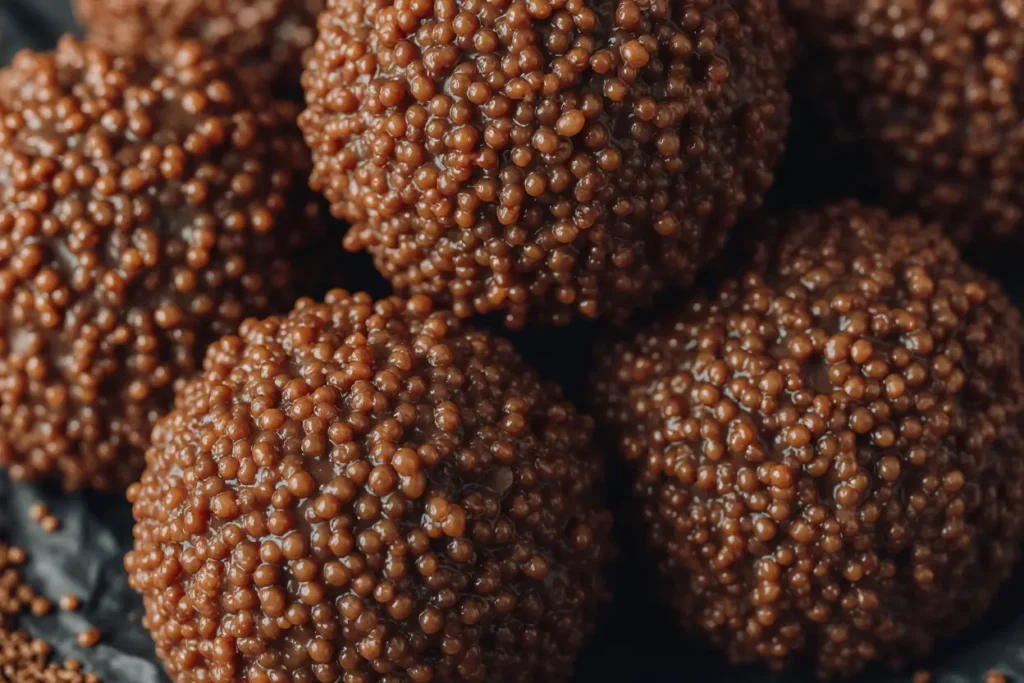
Storing Tips for the Recipe
Short-Term Refrigeration: Store finished truffles in an airtight container with parchment paper between layers to prevent sticking. They’ll maintain optimal quality for 10-14 days when refrigerated at 38-40°F. Avoid storing near strong-smelling foods like onions or garlic, as chocolate readily absorbs surrounding odors through micro-pores in the coating.
Freezing for Extended Storage: Orange chocolate truffles freeze exceptionally well for up to 3 months. Arrange them in a single layer on a baking sheet and freeze until solid (approximately 2 hours), then transfer to freezer-safe containers or bags, removing as much air as possible. This flash-freezing method prevents them from sticking together and maintains individual shapes. Thaw in the refrigerator overnight before serving—never at room temperature, which can cause condensation and sugar bloom (white streaking on the surface).
Make-Ahead Strategy: Prepare the ganache centers up to 5 days before your event and store them uncoated in the refrigerator. Apply coatings 1-3 days before serving for freshest appearance and optimal texture. This staged approach distributes the work across multiple days, reducing holiday stress while ensuring peak quality.
Temperature Transitions: When transporting truffles, use an insulated bag or cooler with ice packs, especially in temperatures above 70°F. Chocolate’s melting point ranges from 86-90°F, so protecting your creations during transit preserves their shape and professional appearance. Allow transported truffles to rest at room temperature for 20 minutes before serving.
Preventing Sugar Bloom: Store truffles in consistent temperature environments, avoiding repeated warming and cooling cycles that cause moisture condensation. This condensation dissolves surface sugar, which recrystallizes upon drying, creating an unappealing white coating. While harmless, sugar bloom diminishes visual appeal.
Gift Packaging Considerations: If giving truffles as gifts that won’t be immediately refrigerated, package them with a small ice pack and include storage instructions. Alternatively, pack them in the morning of delivery and advise recipients to refrigerate upon receipt. Clear communication ensures your handmade gifts are enjoyed at their best.
Conclusion
Orange chocolate Christmas truffles embody the essence of holiday celebration—elegant yet approachable, indulgent yet portion-controlled, and impressive while remaining beginner-friendly. This comprehensive description has equipped you with professional techniques, nutritional insights, and creative variations to make these festive confections your own signature holiday tradition. The combination of rich dark chocolate with bright orange essence creates a flavor profile that resonates across generations, making these truffles perfect for gifting, entertaining, or personal indulgence during the Christmas season. By following these detailed instructions and avoiding common pitfalls, you’ll produce truffle-shop quality results in your home kitchen, impressing family and friends while building confidence in your confectionery skills.
The beauty of this recipe lies in its versatility—adapt it to dietary preferences, experiment with coatings and mix-ins, or maintain the classic preparation for timeless appeal. Each batch represents not just a dessert, but an opportunity to share handmade joy and create lasting memories during the most wonderful time of the year.
Ready to transform your holiday baking repertoire? Start by gathering your ingredients this week, prepare a test batch to perfect your technique, then plan your production schedule for gift-giving or holiday gatherings. Share your creations on social media using #HomemadeTruffles and tag us to join our community of home chocolatiers. Don’t forget to explore our related content on tempering chocolate, creating custom truffle flavors, and building the ultimate holiday dessert menu. Your journey to becoming the go-to confectioner in your circle starts with a single batch of these spectacular orange chocolate Christmas truffles.
FAQs
Can I make these truffles without alcohol?
Absolutely! Replace the Grand Marnier or Cointreau with an equal amount of fresh orange juice, orange extract (use only 1 teaspoon as it’s concentrated), or additional heavy cream. The alcohol primarily adds flavor and slightly softens the ganache texture, but these non-alcoholic alternatives produce equally delicious results suitable for all ages. Some bakers add ¼ teaspoon of orange oil for intense citrus flavor without liquid volume.
Why did my ganache separate or look grainy?
Ganache separation typically occurs from overheating the cream, using chocolate with low cocoa butter content, or adding cold ingredients to warm ganache. To rescue separated ganache, add 1-2 tablespoons of warm cream and blend with an immersion blender until smooth. Graininess usually indicates the chocolate seized from water contact or excessive heat—unfortunately, grainy ganache cannot be fully restored, but it’s still safe to eat and can be used for baking applications.
How far in advance can I make these truffles?
You can prepare orange chocolate truffles up to 2 weeks before serving if stored properly in the refrigerator, or up to 3 months if frozen. For optimal flavor and texture, most chocolatiers recommend making them 3-7 days ahead, which allows flavors to meld while maintaining the freshest possible taste. The orange essence actually intensifies slightly over the first few days, making day-three truffles arguably superior to freshly made ones.
What’s the best chocolate brand to use?
Premium choices include Valrhona, Callebaut, Guittard, Ghirardelli (baking bars, not chips), or Trader Joe’s Pound Plus for budget-friendly quality. The key specification is chocolate with cocoa butter as the primary fat—avoid compounds containing palm kernel oil or other substitutes. For this recipe, chocolate in the 60-70% cacao range provides ideal balance between richness and sweetness, though personal preference should guide your selection.
Can I use milk or white chocolate instead of dark?
Yes, though adjustments are necessary. Milk and white chocolate contain more sugar and less cocoa solids, producing softer ganache. Reduce heavy cream to ⅓ cup when using milk chocolate or ¼ cup for white chocolate to achieve proper consistency. White chocolate pairs exceptionally well with orange, creating an elegant ivory truffle, while milk chocolate produces a sweeter, more approachable flavor profile perfect for those who find dark chocolate too intense.
My truffles won’t roll into smooth balls—what am I doing wrong?
This common issue usually stems from ganache temperature. If too cold, the mixture cracks and won’t form smooth spheres; if too warm, it sticks to hands and loses shape. The solution is working with slightly softened ganache and using the natural heat of your palms minimally—roll each truffle for only 3-5 seconds. Some chocolatiers lightly dust hands with cocoa powder or wear disposable gloves for better control. Alternatively, embrace rustic, imperfect shapes and heavily dust with cocoa powder for an artisanal “rough” truffle aesthetic.
Do I need to temper the coating chocolate?
No! That’s the beauty of this simplified method. Since these truffles are stored in the refrigerator and consumed relatively quickly, proper chocolate tempering (the process of heating and cooling to specific temperatures for snap and shine) isn’t necessary. Simply melt your coating chocolate gently and use it immediately. The truffles will have a softer set and may show slight bloom if left at room temperature extended periods, but this doesn’t affect taste or safety—only professional appearance.
How can I make these truffles look more professional?
Several techniques elevate presentation: use a fork or dipping tool rather than fingers when chocolate-coating to minimize marks; apply a thin first coat, chill, then apply a second coat for ultra-smooth finish; dust cocoa-covered truffles through a fine-mesh sieve for even distribution; create decorative patterns by rolling coated truffles over textured surfaces like cookie stamps; or drizzle with contrasting chocolate using a piping bag for artistic flair. The most important factor is consistency in size and shape—uniform truffles always appear more professional regardless of coating technique.

